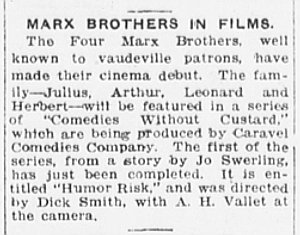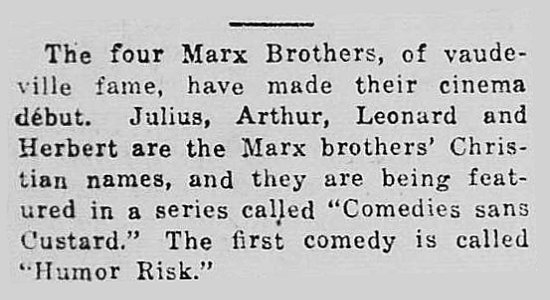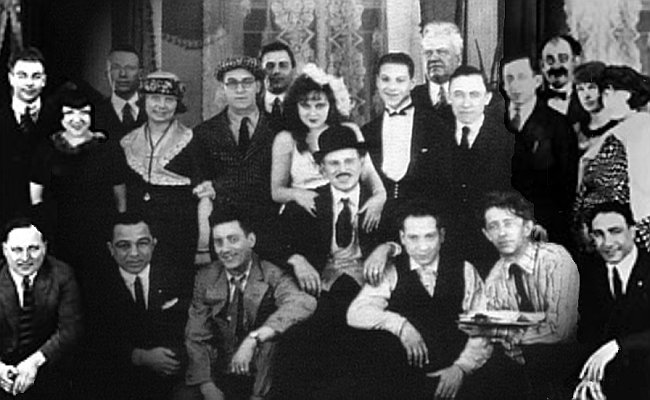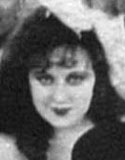
[Main Page] | [History] | [Vaudeville] | [Misc.] | [Films & Film Projects]
 | Mikael Uhlin's Marxology @ marx-brothers.org
[Main Page] | [History] | [Vaudeville] | [Misc.] | [Films & Film Projects] |

|
A Comedy Without Custard produced by Caravel Comedy Company STARRING Watson, Detective and/or the Love Interest (?)
- Harpo
Marx
also featuring
Producer Al Posen
The silent Humor Risk was made privately by the Marx Brothers in 1921. According to popular belief, it was never completed but nevertheless screened once in Bronx in a matinée for kids, whose lack of interest accounted for the movie to remain unreleased. There has also been a rumour that Humor Risk in fact was packaged for distribution in the late 1920s by one of the lesser short comedy distributors, possibly with the title changed. I've collected as much info as possible on this legendary first but lost Marx Brothers-film with a lot of help from Robert Moulton, Steve Massa, Annette Lloyd, Richard Koszarski, Rob Farr, Jo Swerling Jr, Dennis Lambert, Dave O'Malley, Joe Adamson, Matthew Coniam and others. The
earliest known trade paper reference to the film (provided to me by
Richard Koszarski) was in Wid's Daily (later
renamed Film Daily) on 8 April 1921. Under the
headline MARX BROS. IN FILMS? on
page 2, the Wid's piece says that it was reported "yesterday"
that the Brothers are supposed to have signed with Caravel for a series
of two-reelers labelled "comedies
without custard" or "comedies sans custard".
Caravel's office address was given as 130 West 46th
Street. Silent shorts were generally sold to distributors as being part
of a series but it looks like this series started and folded with Humor
Risk. Moving Picture World also wrote
about the film on 16 April 1921, page 738 (unearthed by both Rob Farr
and Annette Lloyd at haroldlloyd.com
and provided to me by Robert Moulton).
 The Evening World 7 April 1921  New York Tribune 21 April 1921 PRODUCTION NOTESRussian-born writer Jo Swerling (who also had written their unsuccesful show Street Cinderella and later got famous for writing the musical Guys and Dolls ) wrote the script and raised $ 6,000. Other financers were the Four Marx Brothers themselves, cartoonist Alvah "Al" Posen (named "producer" by Kyle Crichton), Nathan "Nucky" Sachs and Max Lippman. According to Hector Arce, Oscar "Mike" Mirantz (who was married to Betty Marx' cousin Flo) was also somehow involved, while the 1921 Motion Picture Studio Directory and Trade Annual adds vaudevillian, theatrical director, producer and manager Yeatman Cheatham Alley (1870-1947) as one of the men behind Caravel Comedies. The earliest reports named one John William Kellette as prospective director, but he had to pull out of the project due to ill-health - he died in 1922 - and was replaced by Dick Smith. Robert Moultons' research shows that Smith had just finished up a series of Alice Howell Reelcraft comedies in Chicago at the time, and both he and photographer Vallet have credits on the IMDB. Steve Massa adds that besides being Alice Howell's frequent director and co-star, Dick Smith was her husband from 1910 until his death in 1937. He also acted at L-KO and Vitagraph, where he supported Jimmy Aubrey along with Oliver Hardy. After Humor Risk he directed comedy shorts at Universal until the end of the silent era. Smith was also present when the Marxes were filming Monkey Business in 1931 (see Will B. Johnstone Virtual Gallery). His grandson George Stevens Jr. used to be director general of the American Film Institute. Correspondence, idea file for comic strips, newspaper clippings and original drawings of Al Posen are today hosted by the Syracuse University Library as "the Alvah Posen Papers". I've contacted them to see if there is anything that refers to the Marxes or others involved with Humor Risk, but there isn't and the University have no contact with any present-day relatives. In his very interesting article The Marx Brothers’ Lost Film, Humor Risk: Getting to the Bottom of a Mystery at brentonfilm.com, Marx Brothers scholar Matthew Coniam writes that Posen joined the publicity department of the American Correspondent Film Co. in 1915 (according to Variety), which in turn set up the distribution company Strand Film Services in 1916. Sachs was born in Latvia and appeared in several silent shorts between 1914 and 1921, variously calling himself Nat Sachs, Nathan Sack, Nat Sack, Nathaniel Sacks and Nathaniel Saxe. Matthew Coniam has also found that Nathan Sachs and Max Lippman were partners in a New York law firm. At the time Lippman and Sachs had apparently made a fortune in the oil business and had money to invest, and their involvement with the Marx Brothers didn't end with Humor Risk. A 1929 pre-Crash Variety article described Groucho, Harpo and their producer Sam Harris as "among the heaviest stockholders in the Silver Rod stores", a business owned by Lippman. The firm of Lippman and Sachs represented Gallagher & Shean against Fox in a breach of contract suit, and by 1931 Jo Swerling's brother Matthew Swerling had joined the firm. A woman identified as "Mrs Nathan Sachs" appears on a photo with the Marxes and Chico's wife and daughter on the set of Duck Soup. Coniam adds that Harpo and Groucho were among the pallbearers at Sachs’s funeral in 1928. STUDIO LOCATIONMuch of the information regarding the film is contradictory and it isn't easy to find the exact studio location. In his book The Marx Brothers - Their World of Comedy (1965), Allen Eyles informs that the film was made at Fort Lee Studios in New Jersey and in a studio at 49th Street and 10th Avenue in New York. In The Marx Bros. Scrapbook (1973), Groucho says that they "shot it on the west side of New York". In Charlotte Chandler's book Hello, I Must Be Going (1978), Groucho adds that they "only made two reels over at Fort Lee, and Jo Swerling worked on it. But we were playing at the Palace Theatre at the time, and we used to run over to Weehawken and do a scene". In the chronological list, Chandler sums it up: "shot in New Jersey, lost in New York". Richard Koszarski has done a lot of work on studio locations in this period. He contacted me in March 2002 saying that he doesn't know of any studio on 10th Avenue and 49th Street, nor does he think it likely that a two reeler would have had to be filmed in two different studios in two different states. In 1921, the old Ideal Studio in Hudson Heights, New Jersey was often used for making inexpensive short films. It operated under various names (like the Briggs Studio), and RKO used it to film the WC Fields short The Golf Specialist. The location was at 1996 Boulevard East in an area that today is called West New York. This was the closest New Jersey studio to Weehawken and the 42nd Street ferry, considerably closer than Fort Lee. Matthew Coniam writes that a paragraph in Vaudeville News of 1 April 1921 says that the film is being made “at the Victor Studios”. This, Coniam writes, could explain both the bit about Fort Lee and the bit about two studios since the original Victor studio WAS located at Fort Lee but bought out by Universal in 1917 (and informally referred to as Victor Studios into the 1920s). Another Victor studio, for a while called "the new Victor studio", was opened in 1915 at 645 West 43rd Street, New York. This was promoted as the "cheapest studio in New York to work in", which certainly must have sounded tempting to the producers of Humor Risk. THE STORYLINEThe title of the film was apparently a spoof of the then-popular drama Humoresque, one of the biggest filmhits of 1920, originally a novel by Fannie Hurst that was adapted for Broadway in 1923 and filmed again in 1946. The parody probably ended with the title, since Humoresque is about a Jewish mother who sacrifices everything for her son who grows up to be a successful concert violinist, taking his family out of poverty. The boy is injured in World War I but miraculously recovered through love. Harpo reportedly played the romantic lead in Humor Risk. In his book The Marx Brothers, Kyle Crichton writes:"Harpo played a character named Watson and made his entrance in a high hat, sliding down a coal chute into the basement". In the filmography-section of his book Monkey Business, Simon Louvish adds that Watson was a detective and also that Chico played an Italian. All sources indicates that Groucho appeared as the "old movie" villain and that "the finale showed Groucho, in ball and chain, trudging slowly off into the gloaming." (Crichton). Hector Arce's book Groucho provides a further clue to the action by describing a scene taking place in a cabaret, allowing the inclusion of a dance number. Arce added that Al Posen’s mother visited her son one day and as she sat herself at one of the tables on the set, she had to return for the next three days' shooting for the sake of continuity. Arce also cites a supporting cast that included a married couple named Ralston, along with a chorus line from one of the Shubert theatres. Simon Louvish says that several cast members of the Marxes' vaudeville-show at the time (which was On the Mezzanine Floor, later renamed On The Balcony) "joined in the mayhem". In his 1931 Saturday Evening Post essay Bad Days Are Good Memories, Groucho identifies the leading lady as Mildred Davis, who performed the same task in Harold Lloyd's films until marrying him in 1923. Lately, some new but unconfirmed and uncertain info have popped up. On the ducklist-digest from Sunday, February 27 2000 (Volume 01 : Number 084), a poster claims that Harpo (as detective Watson) wore a deerstalker cap in the film and that Groucho (as the villain) sported a long moustache and was clad in black. Furthermore, Chico was pointed out as the villain's "chuckling henchman"! According to this account, the leading lady was tied up in the cellar by Groucho when Harpo came to her rescue by sliding down the coal chute, thus sending evil Groucho to prison. www.filmthreat.com presents a "Top 10-list of lost films", which includes Humor Risk. New bits in this presentation are the claims that the brothers were working separately rather than as a team and that Zeppo played a playboy and/or a nightclub owner. Matthew Coniam writes that Joe Adamson was told by Dick Smith's stepdaughter Yvonne Stevens that Humor Risk was essentially a compilation of the Marx Brothers' existing routines. This seem to match what Groucho told writer Kyle Crichton: "We did two reels, which didn't make any sense at all. It was just trying to be funny". |
 This shot from Humor Risk is a screen grab from The Marx Brothers in a Nutshell-documentary, provided to me by Robert Moulton. The photo was supplied to Joe Adamson and Bob Weide by Dick Smith's stepdaughter Yvonne Stevens in 1981. On the back of the photo Ms Stevens wrote: "New York - 1921 - 22 ?
The
man standing to Dick Smith's left, with the black tie, may be Jo
Swerling. His son, Jo Swerling Jr (who wasn't born at the time), isn't
sure but says that this man bears a slight resemblance to his father
and could be him.
THE LEADING LADYMildred Davis?In an email sent to me on 3 February 2000, Robert Moulton suggested that Groucho was misremembering about Mildred Davis; "By 1919 Mildred Davis was already Harold Lloyd's full time leading lady in Hollywood, a role that continued into 1923". Additionally, despite being born in Brooklyn, New York on 1 January 1900, it appears that Mildred was in Los Angeles already by 1914, as her brother Jack Davis (also an actor) was born there on 5 April 1914. Jobyna Ralston?Another email from Steve Massa on 30 October 2001 offered a very logical explanation - the woman in question was in fact Jobyna Lancaster Ralston, who became Lloyd's leading lady in 1923 when Mildred Davis retired to become Mrs. Lloyd. The research of Dennis Lambert shows that Jobyna knew the Marx Brothers closely. Jobyna Ralston was born on 21 November 1899 in South Pittsburg, Tennessee. It has always been stated that she was born in 1900, which is also listed on her tombstone. However, investigation by Dennis Lambert has revealed that 1899 is the correct year. It appear in census records and is also confirmed by the announcement of her birth in the local newspaper dated 24 November 1899. She was named after actress Jobyna Howland, a favorite of her stagestruck parents Joe Ralston and Sara "Kempt" Brady Ralston. They may be the Mr. & Mrs. Ralston rumoured to be in the Humor Risk-cast. They were well-to-do and may have kicked in with money for the production. Jeffrey Vance at the Harold Lloyd Trust added that Jobyna Ralston had a first marriage at a very young age and that the "Mr. and Mrs. Ralston" may not be Jobyna's parents but rather her and her first husband. Jobyna appeared in some 1920 Reelcraft comedies with comedian Billy Quirk (for example Don't Mary) and was studying acting and dancing at Ned Wayburn's school in New York in 1921. She later landed a theatrical role on Broadway singing and dancing chorus in the musical comedy Two Little Girls in Blue. The show ran a total of 135-performances at the George M. Cohan's Theatre from 3 May 1921 to 27 August 1921. In the fall, Jobyna appeared as an extra in Harold Lloyd's The Sailor-Made Man, which was released in December 1921 and featured Mildred Davis as leading lady. The Sailor-Made Man was filmed from 26 August to 21 October 1921 in Southern California. Jobyna remained in Hollywood and in 1922 she worked for Max Linder (Three Must-Get-Theirs), Charley Chase's brother Paul Parrott and Hal Roach. In 1923 Jobyna was listed as a WAMPAS Baby Star, an award the Western Association of Motion Picture Advertisers bestowed upon 13 Hollywood actresses perceived as most likely to succeed. And Jobyna made it, co-starring with Harold Lloyd in five of his best silent features: Why Worry? (1923), Hot Water (1924), Girl Shy (1924), The Freshman (1925), For Heaven's Sake (1926) and The Kid Brother (1927). In 1927, Jobyna worked with Eddie Cantor in the silent Special Delivery (directed by Roscoe Arbuckle) and she also co-starred with Richard Arlen (real name Van Mattimore) in the first Oscar-winning film Wings. Jobyna and Richard Arlen got married the year after. The engagement announcement appeared in The Independent, St Petersburg, Florida on 17 August 1928, and they eventually had one son, Richard Arlen Jr. The research of Dennis Lambert shows that one of the Marx Brothers nicknamed Richard Arlen Jr "Elmer" a few months before he was born. Jobyna Ralston's film career ended after two early talkies. In her last film Rough Waters from 1930, she played against Rin Tin Tin. Jobyna and Richard divorced in 1945 and Jobyna died in Woodland Hills, California, on 22 January 1967. People at haroldlloyd.com and Classic Films agrees that the leading lady of Humor Risk looks like Jobyna Ralston, while some of her relatives (her cousin Fay Carney Melton and Joe Hughes Beasley, whose great-uncle was married to Jobyna's maternal aunt Anthia Brady Hughes) are unable to identify her. Joe Beasley (who is curator of the Brady-Hughes-Beasley Archives in McMinnville, Tennessee) adds that there is "no oral history in the family of her being in the Marx Brothers' movie. Just primary about "Wings" and the Harold Lloyd movies". Esther Ralston?Dennis Lambert has compared the Humor Risk-photo with several that he has of Jobyna and he finds the similarities between her and the lady in the picture uncanny. However, he also thinks that the lady in the picture looks a lot like actress Esther Ralston. Esther bears a striking resemblance to Jobyna but they are not kin to one another. According to one website, Esther Ralston and her family had their own traveling show, with her parents being owners and actors in the play. So, there's a possibility that the leading lady of Humor Risk may be Esther Ralston and that her parents also were in the movie. On the other hand, Esther was in films already from 1916 and although she lived until 1994 and was interviewed extensively, she never mentioned working with the Marx Bros. Helen Kane?In digging more info on Jobyna, Dennis Lambert acquired a book on Hollywood stars from 1930. In this book was not only a picture of Jobyna but also of Helen Kane, "The Boop-a-Doop Girl", who inspired both Betty Boop and Marilyn Monroe and who physically looks very much like the leading lady of Humor Risk. She was born in the Bronx as Helen Schroeder (or Schroader) and appeared in numerous stage plays in New York before being discovered for films. The book gives her birth date as 4 August 1908, which would make her quite young to have appeared in Humor Risk, but other sources says she was born in 1903 and if so, the chronology would fit. Helen went with the Marxes to Britain (On The Balcony) in 1922, so there's a definite connection between them. But why then did Groucho mention "Harold Lloyd's leading lady" and not the "Boop-a-Doop Girl" in connection with Humor Risk? Another misremembrance in his old age? 
The Leading Lady
So who was the leading lady in Humor Risk? Will we ever find out? The chronology seems to talk in favour of Jobyna Ralston. In 1921, her career was still in progress while Mildred Davis and Esther Ralston already had been making films for a couple of years. And if Humor Risk was filmed during a couple of weeks in April 1921, Jobyna would still have found time to appear in Two Little Girls in Blue (3 May to 27 August 1921) and Harold Lloyd's The Sailor-Made Man (26 August to 21 October 1921). On the other hand, Helen Kane worked with the Marxes on stage during this period, which would fit the claim from Simon Louvish that several cast members of the Marxes' vaudeville-show at the time "joined in the mayhem". "Please check your attic"Kyle Crichton claims that the film was destroyed but for one rogue print and he implies further that the Marxes' friends sometimes used this print, actual or imagined, to engage in some jovial blackmail. Hector Arce in turn claims that the only print was burned and the negative consigned to Al Posen's closet. Simon Louvish says that Alexander Woollcott demanded a screening of Humor Risk at the end of the 1920s after the Marx Brothers had made it on Broadway with I'll Say She Is! Al Posen came up with a can of film which, the projectionist discovered upon cracking it open, contained only the negative. The Marx Brothers reportedly slunk off, forgetting the can of negative film in the projection booth from whence it promptly vanished forever - unless it's filed somewhere under another title. Matthew Coniam suggests that Humor Risk was picked up by Reelcraft (which already had connections to Dick Smith and Jobyna Ralston), renamed and scheduled for release but "lost" (again) when Reelcraft went into liquidation in 1922. Coniam's theory is backed up with the assurance from "a film historian" who's actually seen a Reelcraft press release from early 1922 listing performers to be seen in their latest batch of titles, among them the Four Marx Brothers. Neither Humor Risk nor any other title was mentioned in this press release, but – like Coniam puts it - "what else could it be? That was the only movie the Marx Brothers had made that year". Reelcraft's existing holdings of nearly 200 negatives were purchased at auction in October 1922 by Export & Import Film Company, Inc., so there's still a possibility that the film exists somewhere. Like it's said on IMDb: "Please check your attic"! |